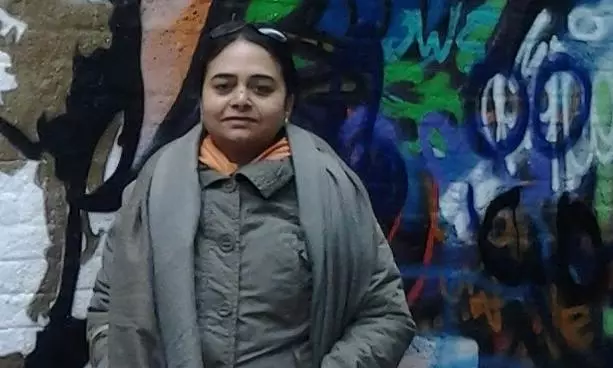Documenting the divine

Environmentalist and photographer Indu Chinta, whose works are on display at the Indian Photography Festival 2019, believes in preserving cultural heritage through her work.
 Makkam Theyyam is fairly popular in and around Kolathanad. Families worship the goddess and organize the Theyyam when they desire offspring.
Makkam Theyyam is fairly popular in and around Kolathanad. Families worship the goddess and organize the Theyyam when they desire offspring. Karim Chamundi: Believed to be the daughter of Lord Shiva, this Theyyam belongs to the category of yakshadaivangal (celestial beings).
Karim Chamundi: Believed to be the daughter of Lord Shiva, this Theyyam belongs to the category of yakshadaivangal (celestial beings).
Photographer Indu Chinta is working hard for Theyyam — a traditional expression of religious worship in Kerala — to be recognised as “intangible cultural heritage” under the UNESCO. An environmentalist, who was working on a project for IIT Madras, Indu quit her job in 2017 to document North Kerala’s vibrant Theyyam art form through photographs. Two years and two seasons of Theyyam later, she is now a recognisable face in the entire district of Kannur.
 Kotilangattu Bhagavathi is the amsa (aspect) of saptamatrikas, the seven divine mothers.
Kotilangattu Bhagavathi is the amsa (aspect) of saptamatrikas, the seven divine mothers.
“Theyyam is a ritualistic art that is performed in traditional temples in North Kerala called Kavus and/or ancestral homes. It cannot be performed on a stage like a classical dance. Hence, to capture both its artistic richness and to spread awareness outside of this region, photography became a necessary instrument of documentation,” says Indu, who has done her Masters in Environmental Engineering from the University of Illinois.
 Puli Karinkali is a mother tigress, a manifestation of Parvati.
Puli Karinkali is a mother tigress, a manifestation of Parvati.
Interestingly, what was supposed to be a week-long journey unexpectedly extended to five months in 2018. “I learnt not to treat them as ‘subjects’ but to connect with the people that they are. Each time I would go to document a Theyyam, I would sit with the artists in the makeshift green rooms, either in conversation or in silence. I would watch them for hours as they prepared to become ‘God’. I would visit them in their homes and spend time with their families,” explains Indu, adding, “Developing relationships with people has given my photography a real and honest approach. It also helped me transition from an outsider to an insider. Such is the rapport that we do not feel the language barrier between us — I speak in English and they speak in Malayalam and yet, we understand each other perfectly well.”
While there are over 400 Theyyams being performed, a large number of them are portrayals of Goddesses. Interestingly, with the exception of one woman performer, all other Theyyam artists are men, who slip into both roles with equal ease.
 Indu Chinta
Indu Chinta
Talking about the most dangerous situation she has ever encountered while on assignment, Indu says, “Kannur is known for political violence and people are charged with their respective sentiments. Temple festivals, which are usually associated with Theyyam, often become grounds for law and order and crowds can turn into mobs, calling for police intervention. Naturally, there is a palpable tension in the atmosphere.” She recalls, “On more than one occasion, I would be the lone woman photographer and outsider in such places at odd hours of the day. Once, after covering one such temple festival, my driver and I got back to our car. Even as we were waiting for the traffic to clear, all of a sudden, a group of young men emerged with sticks from the crowd, vandalised the windscreen of the car right next to ours and ran away! All we could do was cower and pray! Maybe it was the blessings of the Theyyam that nothing happened to me, but I was that close!”

